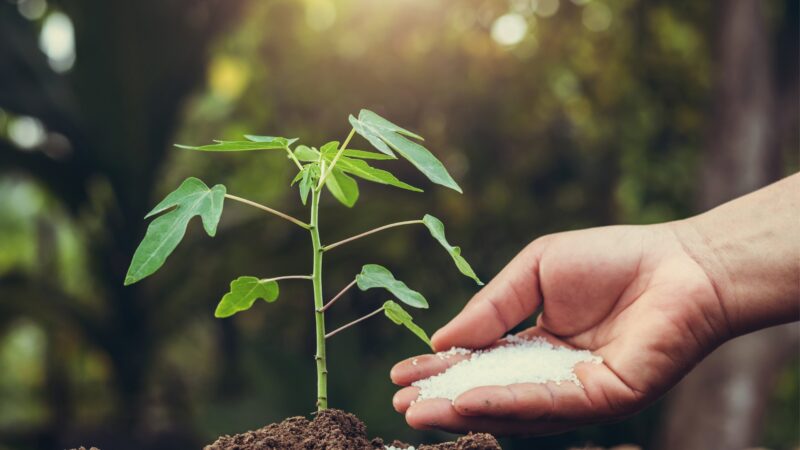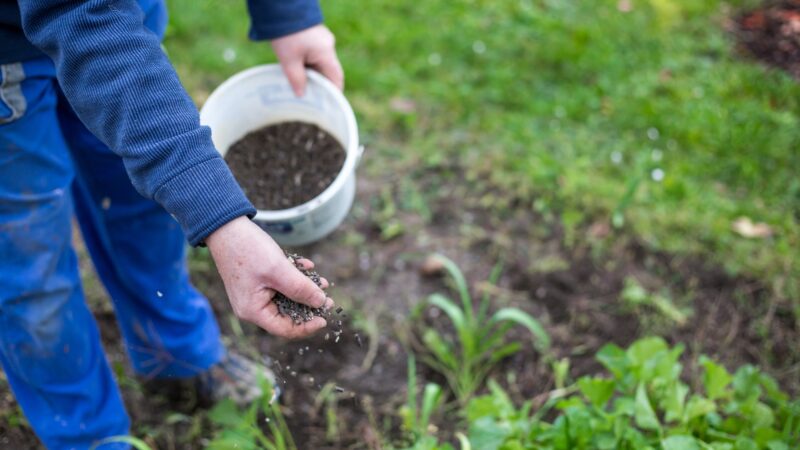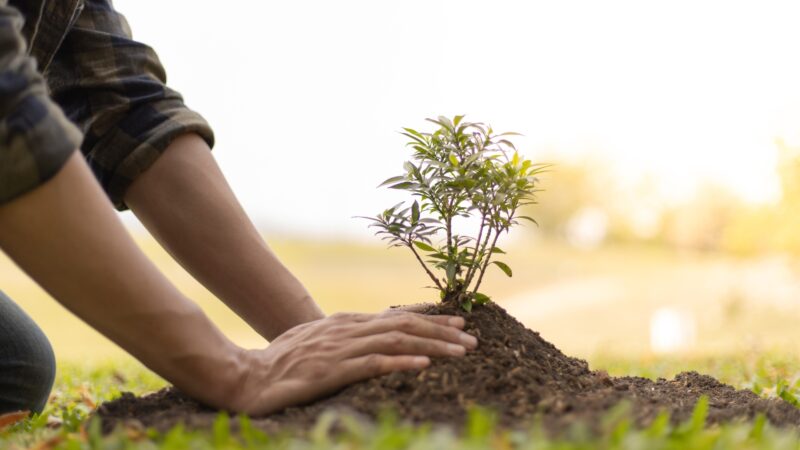Potassium plays a key role in plant chemistry and physiology, specifically with the movement of water, nutrient uptake, and carbohydrate content within plants.
As such, if your soil lacks potassium, your plants may grow stunted and have reduced yields. This is why you need to know fertilizers that are high in potassium.
Fertilizer that is high in potassium are alfalfa (lucerne), bat guano, burned cucumber skins, clay (illite), compost, granite dust, greensand, kelp, manure, sawdust, soybean meal, sulfate of potash magnesia, and wood ash.
This article will provide you with everything you need to know about the benefits of potassium for plants, what fertilizers are high in potassium, how to apply them, and more interesting information. Read further for more!
What Does Potassium Do For Plants?

Potassium is an essential macronutrient that helps in plant growth. It is associated with water movement, nutrient uptake, and carbohydrates found in plant tissue.
For perennial crops, potassium helps them build resistance to get through the winter seasons. Other roles include increasing root growth, improving drought resistance, and reducing the risk of diseases.
Do I Need a High Potassium Fertilizer?

It depends on your soil. This is why gardeners need to conduct soil tests before proceeding with fertilization. If your soil is deficient in potassium, you would need to use a fertilizer that has high amounts of it.
Why Do Plants Need Potassium?

Plants need potassium for plant growth and to achieve optimum yield. Soils usually contain 20,000 parts per million of potassium, but only small amounts are readily available for plants at any given time. This is why we must supplement this using fertilizers, especially if the soil is deficient.
How Do I Know When My Plants Need Potassium?
You would know this when you conduct a soil test, but you can also tell by appearance alone. Potassium-deficient plants are drooping or wilted and have an overall stocky appearance.
Leaf blades are small and may be dark to bluish-green since the growth of young leaves is inhibited. Some plants may have blotchy or inverted V-shaped chlorosis on their older leaves.
What Fertilizer Is High in Potassium?
Alfalfa (Lucerne)
Alfalfa, a kind of legume, is often dehydrated and turned into a meal or pellets to use often as animal feed. It can also be used as a soil amendment since it increases organic content and offers high availability of trace minerals and triacontanol, a natural growth stimulant.
The typical analysis for alfalfa is 3-2-1 or 2-1-2. However, its potassium content can reach as high as 3%. It is readily available at feed stores and has a slow release time of 1 to 4 months. One disadvantage is that it may still contain trace seeds from the plant.
Bat Guano
Bat guano is an agricultural fertilizer used since the 19th century and is made from bat excrement that is turned into pellets. Although it is considered a natural nitrogenous fertilizer, it also provides a small amount of potassium. Specifically, it has an NPK analysis of 8-5-1.5.
Burned Cucumber Skins
These brownish, roasted peels of cucumbers are cut into several small pieces and added directly into the soil as a natural source of both phosphorus and potassium. It can also be dried out under the sun, burnt, pulverized, and turned into ash before applying as fertilizer or compost.
Burned cucumber skins have a whopping NPK analysis of 0-11-27. That’s the highest amount of potassium on this list, and it’s also a very inexpensive choice.
Clay (Illite)
Clay that contains illite is rich in potassium and can even be used as an active ingredient to produce potassium-nitrogen fertilizers and potassium chloride. It usually contains 3.5% to 8.3% potassium, which is significantly higher compared to clay containing kaolinite.
Compost
Compost is considered a soil amendment instead of fertilizer since its main functions are to loosen up the soil, improve its drainage and ventilation, and increase its nutrient-holding capacity. The organic matter present in compost provides food for earthworms and beneficial microorganisms to thrive.
There is about 1.13% to 2% potassium found in compost since most of it is leached when compost absorbs water, reducing as much as 25% of potassium levels. To provide 10% potassium, you would need to apply 70 pounds of compost per 1,000 square feet of gardening area, but this is costly.
Granite Dust
As the name suggests, granite dust is made from crushed granite. Although it is used in construction and engineering, it is a good source of phosphorus and potassium, but its nutrient availability is slow-releasing. However. it is most commonly used as soil amendment instead of fertilizer. The NPK analysis of granite dust is 0-1-6.
Greensand
Greensand is formed in shallow marine seas and is largely composed of a unique mineral called glauconite. It increases the water retention and nutrient-uptake capacity of soils. In the past, it was used as an inexpensive fertilizer, but today, it is considered more of a soil conditioner.
Pure glauconite alone contains up to 8% potassium and small amounts of trace elements. Since greensand also contains non-beneficial constituents, its potassium content may fall between 0.1% to 7%. It is the ideal fertilizer to use for organic agriculture when your soil needs a natural source of potassium.
Kelp
Kelp is available as a meal or powder (which contains milled seaweed) and is used mainly as a source of trace minerals. It is often combined with fish-based fertilizers, such as fish meal and fish emulsions, to enhance plant growth.
In meal form, kelp has insignificant amounts of potassium as well as nitrogen and phosphorus and has, therefore, no NPK analysis. In powdered form, it has an NPK analysis of 1-0.1-2 or 1-0-4. It has a rapid release time of up to 1 month.
Manure
Livestock animals can excrete 80% to 90% of the potassium that is fed to them. For example, if you feed your cows with 100 acres of corn, they can produce manure with enough potassium content to fertilize 75 acres of planting area. Potassium in manure is water-soluble, making it readily available for plants to absorb.
Sawdust
Composted sawdust, to be specific, is a good source of nitrogen, phosphorus, and potassium. Pure sawdust should not be used as fertilizer since it does not contain any significant amount of essential macronutrients that can aid in plant growth. Composted sawdust contains 0.017% of potassium.
Soybean Meal
Although used mainly as an animal feed product, soybean meal is produced by heating, flaking, and grounding soybeans. It is readily available at feed stores and is considered a slow-release nitrogen fertilizer, but it has considerable amounts of potassium.
The typical NPK analysis for soybean meal is 7-2-1 or 7-1-2. It must not be applied at the time of planting since it can inhibit seed germination. Unfortunately, almost half of the conventionally grown soy in the market are GMOs.
Sulfate of Potash Magnesia
Also called potassium-magnesium sulfate, this type of fertilizer contains about 22% phosphate and is naturally occurring as the mineral, langbeinite, which is usually added to commercial fertilizers. The sulfate of potash magnesia is an excellent source of both water-soluble potassium and magnesium.
Wood Ash
Wood ash is a good source of soluble potassium, but is not recommended to be consistently used as fertilizer or soil amendment because they raise the pH levels of soil rapidly and can become caustic. Unless you need your pH levels modified, use wood ash sparingly.
The average wood ash has an NPK analysis of 0-1-3. However, it can reach concentrations of up to 5%, along with other elements such as calcium, magnesium, and sulfur.
How to Use High Potassium Fertilizer?
| Potassium Fertilizer | Application |
| Alfalfa | Till in 2 to 5 pounds of alfalfa per 100 square feet of planting area. It can also be soaked overnight in water and added to compost prior to application for faster decomposition. |
| Bat Guano | Apply 5 pounds of bat guano per 100 square feet of planting area. If used as a tea, dilute 3 teaspoons of bat guano per gallon of water then spray directly onto plant foliage. |
| Burned Cucumber Skins | Incorporate 2 cucumber skins per plant once every 3 weeks. When using cucumber skin ash, simply sprinkle 2 teaspoons of it on the soil of small plants or 4 to 5 teaspoons for bigger plants. |
| Clay (Illite) | There is no specific application rate that is widely prescribed as of this writing. However, soils should not contain clay greater than 30% or it will cause plant problems. |
| Compost | Using a garden fork or other similar tools, work in and evenly spread 1 to 2 inches of compost into the top 3- to 5-inch layer of the soil. |
| Granite Dust | Apply 10 to 15 pounds of granite dust per 100 square feet of planting area. For potted plants, use half a teaspoon per inch of pot diameter. Make sure to thoroughly incorporate it into the soil. |
| Greensand | For lawns, apply 10 to 20 pounds per 1,000 square feet of planting area. For flowers and vegetables, apply 25 to 30 pounds and for container plants, apply only 2 to 3 tablespoons per pot. |
| Kelp | For kelp meal, till in 1 pound per 100 square feet of planting area. For kelp powder, mix ¼ to ½ teaspoon of product per gallon of water then apply via an irrigation system or using a foliar spray. |
| Manure | Incorporate manure 6 to 8 inches deep into the soil and rake it so that it is evenly spread all over the soil. Use 50, 150, or 200 pounds of poultry, cattle, and horse manure, respectively, per 1,000 square feet of planting area. |
| Sawdust | There is no specific application rate that is widely prescribed as of this writing. However, composted sawdust should be used in small amounts only when used alone. |
| Soybean Meal | Apply 1 to 2 pounds of soybean meal per 100 square feet of planting area. Use a tiller or shovel to thoroughly incorporate up to half a foot into the soil. |
| Sulfate of Potash Magnesia | Apply by spreading on soil or by broadcast treatment. Work in 1 pound of product per 1,000 square feet of application than water. |
| Wood Ash | Prior to application, moisten the soil of the plant then lightly sprinkle the wood ash all over it. Incorporate thoroughly by raking or tilling with a rate of 10 to 15 pounds of wood ash per 1,000 square feet of planting area. |
List of Sources
Organic Fertilizers – https://cmg.extension.colostate.edu/Gardennotes/234.pdf
Greensand as a Soil Amendment – https://ucanr.edu/sites/nm/files/76652.pdf